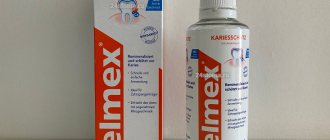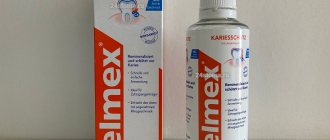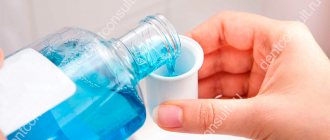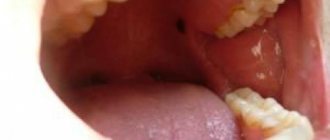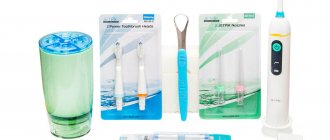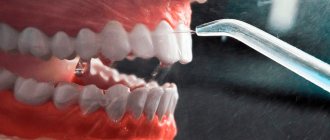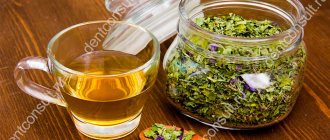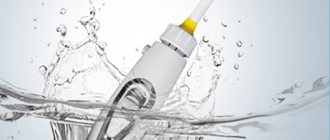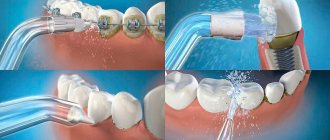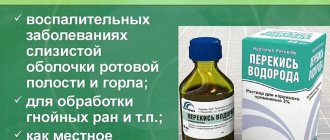Why does your throat hurt and how not to gargle?
Every person experiences a sore throat on average at least 2–3 times a year [1]. The cause of tickling, discomfort, and sometimes severe pain, which significantly reduces the quality of life, in the vast majority of cases is a respiratory infection. Today, approximately 300 “causative agents of sore throat” are known, more than 200 of which are viruses. It is believed that about 85–95% of cases of sore throat in adults and 70% in children are caused by a viral infection [2]. In other cases, a sore throat is caused by bacteria and, much less commonly, fungi. Sometimes pain is caused by non-infectious causes, but these cases are rather the exception to the rule.
The clinical picture of a sore throat is quite typical: swelling of the pharynx, enlarged tonsils, accompanied by soreness and discomfort of varying degrees. The goal of treatment is to eliminate pain, difficulty swallowing, sore throat, irritation of the throat and dry cough [3]. According to domestic recommendations, patients are prescribed antiseptic local medications, a gentle diet, warm compresses on the front surface of the neck, steam inhalations and gargles [3]. However, the attitude of doctors towards rinsing is far from clear.
It is known that the mucus, which normally covers the lining of the pharynx, performs many important functions. It mechanically protects the epithelium from the action of damaging factors, including microbes, and also contains immunocompetent cells. In addition, the mucous membrane produces interferon, immunoglobulins and lysozyme, thus participating in the processes of local immunity [3].
Intensive rinsing with concentrated solutions helps wash away mucus, which leads to disruption of the protective barrier of the mucous membrane and a decrease in the immune response. But rinsing also has a therapeutic effect, providing moisture to the mucous membrane and mechanically washing away infectious agents.
The balance between benefit and harm that overly active manipulations can bring is precarious. The effect of a popular procedure largely depends on what means and how are used to carry it out.
NB! It is strictly not recommended to use concentrated solutions of antiseptics for rinsing, including chlorhexidine, potassium permanganate, and other agents in doses exceeding the recommended ones [3].
When requesting gargling preparations, the chief officer has 3 tasks:
- Help you decide what solution to gargle with and choose exactly the product that best suits the visitor.
- Explain the rules of application.
- Emphasize the risks associated with overdosing.
In order for the consultation to be correct, it is better to start it with clarifying questions.
Antiseptics for prevention
The mouth requires constant disinfection. A toothbrush, mouth rinses, and dental floss are essential hygiene products. In cases where these care products are not sufficient, antibacterial and anti-inflammatory drugs are prescribed.
Antiseptics for the oral cavity are classified into:
- Anti-inflammatory drugs are considered indispensable for periodontitis, gingitis, and stomatitis. Their principle of action is to destroy pathogenic microflora, prevent its spread and reduce swelling of the mucous membranes.
- Painkillers – contains an analgesic agent, used to reduce pain and perform surgical interventions.
- Wound healing - medications are prescribed for injuries and burns of the oral cavity.
- Antimicrobial – prevents the growth of bacteria in the mouth.
- Deodorants – prevent the appearance of unpleasant odor from the mouth.
Medicines are available in several forms: rinses, tablets, ointments and gels. Indications for use:
- after performing dental procedures;
- in the treatment of infectious diseases;
- during preventive actions.
Antiseptics are popular due to their wide range of actions:
- improving immunity;
- pain relief and inflammation prevention;
- tissue regeneration;
- elimination of suppuration.
Antiseptic ointments are used for diseases: gingitis and stomatitis. They have a reinforced composition and have a triple effect:
- destroy bacteria;
- relieve pain;
- accelerate mucosal regeneration.
Let's look at drugs that prevent inflammation and are suitable for daily use:
- Dentinox – release form – gel, applied topically.
- Lakalut Active is a toothpaste that prevents caries and various inflammations.
- Metrogyl Denta - available in gel form, relieves pain and prevents inflammatory processes.
- Tantum Verde - release form - spray, is a remedy for inflammation.
- Sebidine - antiseptic tablets.
- Cholisal is a gel for gums with an anti-inflammatory effect.
Toothpastes and gels are best used in the morning, and sprays and tablets are recommended to be used throughout the day.
It is not correct to believe that antiseptics are a panacea. Their effect is superficial, and in case of deep inflammation they will not have the desired effect. Such drugs are used at the first initial stage of the disease or are used for complex treatment.
Clarifications and preferences
First of all, 3 points should be specified:
- Who has a sore throat - a child or an adult?
- How severe is the pain?
- What other symptoms accompany it?
In the case of a child, it is important to remind the client to consult with a pediatrician before recommending any gargle solution for children. Mild to moderate pain, as a rule, speaks in favor of rhinovirus infection. Severe sore throat may be associated with infection with the influenza virus, adenovirus. If they are accompanied by a significant increase in temperature (above 39.4 °C), then the likelihood of a bacterial origin of the pain is high, that is, we are talking about streptococcal (less commonly, staphylococcal) pharyngitis [4].
Note that even with bacterial inflammation of the pharynx, the advisability of using antibiotics remains not so clear. According to research, in 90% of patients, the symptoms of acute pharyngitis disappear within 1 week, regardless of taking antibiotics. The duration of the disease under the influence of antibacterial drugs decreases only by 16 hours [4]. However, it is up to the doctor to decide whether antibiotics are needed or not.
Therefore, if there are signs of a bacterial infection, it is important to advise the visitor to consult a doctor.
Only after this can you begin to choose gargling medications that will help improve your condition even before visiting the doctor.
Recommendations for using rinse aid
In order for the benefits of the rinse aid to be visible from the first days of use, it is recommended to follow certain rules for its use:
- The liquid does not need to be diluted if it is used to cleanse the oral cavity by adults or children over 15 years of age. Children from 12 to 15 years old are recommended to mix the solution with boiled water in a 1:1 ratio. Children under 12 years of age should buy only specialized children's rinses, and before purchasing them, consultation with a dentist is required.
- Rinse for 2-3 minutes, after which the liquid should be spat out.
- After completing the rinsing procedure, it is better to refrain from eating and drinking for 10-15 minutes. This time should be enough for the active components of the liquid to neutralize bacteria and cleanse the oral cavity, restoring freshness to your breath.
It is advisable to use a mouthwash after each brushing of your teeth.
Rinse products are not ingested, but their constituent components still partially enter the human body. That is why in some cases it is worth refraining from using them. Rinse aids are contraindicated:
- Persons suffering from allergies (if the product contains allergens).
- People for whom alcoholic beverages are contraindicated should avoid alcohol-containing varieties.
- Children under 6 years old. For oral hygiene, they only need to use water.
- Pregnant and breastfeeding women.
The rinse is part of a comprehensive hygiene procedure that allows you to maintain a healthy oral cavity. When choosing one, you should definitely consult a dentist. After all, he is the one who can determine the presence of problems with teeth or gums and give recommendations on how to eliminate them.
Salt rinses
Saline solution is one of the most popular gargles for a sore or sore throat. Its effectiveness is due to its ability to prevent drying of the mucous membrane of the pharynx and tonsils, and thus prevent the formation of microcracks, as well as the further development of the inflammatory process [2].
Rinsing with sea water has a positive effect. Unlike sodium chloride solution, sea water has some antiseptic effect due to its iodine content. In addition, it contains microelements that help strengthen local immunity, such as zinc and selenium.
Hypertonic solutions exert osmotic and tissue pressure on the microflora, as a result of which the function of cell membranes is disrupted and bacteria die. The ability of saline solutions to mechanically wash away infectious agents from the tonsils and posterior pharyngeal wall should not be discounted [2].
Gargling with saline solutions is recommended for sore throat not only by domestic, but also by Western experts [5]. Sodium chloride solution and sea water help reduce the severity of mild to moderate sore throat, but for severe pain, according to international recommendations for the treatment of sore throat, it should be combined with analgesics such as paracetamol and ibuprofen [5].
By the way, it is quite possible to suggest a visitor who is worried about a severe sore throat to combine gargling with taking over-the-counter NSAIDs. Thus, we obtain appropriate and “clinically justified” upsale of drugs.
It must be emphasized that solutions of sodium chloride or sea salt are the best recommendation if you need to decide on a gargle specifically for children, since there are no age restrictions: the main thing is that the child already knows how to perform this procedure. In addition, saline solutions for gargling not only help relieve sore throats, but also have a preventive effect against pathogens of respiratory infections.
According to a study by Japanese scientists involving more than 19,500 children 2–6 years old, gargling with a salt solution, green tea, and even tap water at least once a day reduced the likelihood of ARVI and fever due to ARVI [6].
Functions of mouth rinses
The procedure for rinsing the mouth is very easy and takes only a few minutes a day. In order for the liquid to be evenly distributed in the mouth, the head is tilted back slightly, after which the usual rinsing movements are performed.
A mouthwash is a special liquid for rinsing the mouth.
As an additional personal hygiene product, mouthwashes perform a number of useful functions, including:
- removing food debris;
- fight against microbes that provoke the development of caries and tartar;
- prevention of dental problems (gum inflammation, caries, etc.);
- neutralization of unpleasant odors;
Using mouthwash helps keep your teeth strong and healthy.
Medicinal plants to help
Herbal preparations are usually well tolerated. Decoctions, infusions, as well as solutions of medicinal plant extracts are quite widely used for gargling in domestic practice [2].
pharmaceutical camomile
Among the most popular preparations for gargling are infusions and extracts of chamomile, known for its antiseptic and anti-inflammatory properties [7]. For rinsing, we can recommend both infusions, which are prepared independently from medicinal plant materials, and concentrated extracts, which must be diluted before use.
As an advertisement
In the complex treatment of diseases of the ENT organs and oral cavity (pharyngitis, tonsillitis, stomatitis, gingivitis), an infusion of chamomile flowers is used topically for rinsing.
The composition of chamomile flowers includes essential oil, flavonoids, coumarins, phytosterols, phenolcarboxylic acids, choline, organic acids, vitamins A, C, mucus, bitterness, microelements, etc. Thanks to the chamazulene present in the essential oil of flowers, the infusion has an anti-inflammatory, anesthetic effect, Helps activate the body's immune system.
To avoid destruction of the active ingredients, it is recommended to heat the water for infusion no higher than 90 degrees. An alternative to conventional packaging is convenient filter bags.
To rinse the mouth and throat, use 1/2–1 glass of warm infusion 3–5 times a day.
THERE ARE CONTRAINDICATIONS. YOU SHOULD CONSULT WITH A SPECIALIST.
Calendula officinalis
Calendula flowers have a pronounced antiseptic, anti-inflammatory and wound-healing effect. For gargling, you can offer medicinal plant materials from which an infusion is prepared, or a herbal preparation - a tincture for gargling. To prepare the solution, you need to dilute 1 teaspoon of tincture in a glass of non-hot boiled water.
Eucalyptus twig
A very popular remedy used in ENT practice. Eucalyptus leaves contain 3% essential oils, about 80% of which is the terpene cineole, which has pronounced antiseptic properties. Thanks to its unique composition, eucalyptus oil exhibits a powerful bactericidal effect, suppressing the development of staphylococcus and a number of other microorganisms [7].
For gargling, use infusion and tincture of eucalyptus leaves.
It is important to understand how to properly prepare a gargling solution based on eucalyptus tincture. To do this, take 10–15 drops of tincture and dilute it in a glass of warm boiled water. An alcoholic extract of eucalyptus leaves is also popular, which must also be diluted with water before use so as not to exceed the recommended dosage. Otherwise, due to too high an alcohol concentration, the solution may dry out the pharyngeal mucosa.
NB! The instructions indicate age restrictions for the use of extracts and tinctures [8].
Sangviritrin
An antimicrobial agent of plant origin, which is obtained from the herb Macleaia cordata and Macleaia small-fruited. Active against gram-positive and gram-negative bacteria, as well as some fungi. The easiest way to make a solution for gargling is to dilute 1 teaspoon of the drug in 200 ml of boiled water. The drug has no age restrictions [8].
Antiseptic solutions for gargling
Several antiseptic gargles are registered on the domestic market, which are also useful for inflammation. When recommending a specific drug, age restrictions should be taken into account.
Clinical studies have not been conducted to prove the effectiveness of topical use of antiseptics for sore throat. In the West, antiseptics are not used for this purpose, but in domestic practice they are recommended for use [3]. Let's remember the most famous drugs.
- Hydrogen peroxide
A very economical, although not very comfortable to use, antiseptic gargle. Upon contact with the damaged mucous membrane of the pharynx and tonsils, it releases active oxygen, due to which mechanical cleansing and inactivation of organic substances - proteins and pus - occurs. The antiseptic effect of hydrogen peroxide cannot be called powerful - the number of microorganisms when used decreases slightly and not for long [8]. To rinse the mouth and throat, use a 0.25% solution (diluted with a 3% solution in a ratio of 1:11). - Povidone-iodine
Upon contact with mucous membranes, it releases iodine, which has a powerful antiseptic and anti-inflammatory effect. Povidone-iodine preparations are active not only against bacteria, but also against viruses, fungi and even protozoa [8]. They are produced in the form of concentrated solutions, which are diluted immediately before use. Rinse solutions have a specific taste of iodine.NB! Povidone-iodine preparations are contraindicated in children under 6 years of age.
- Hexethidine
Another antiseptic that is suitable for gargling. It has a wide spectrum of antibacterial and antifungal effects, in particular against gram-positive bacteria and fungi of the genus Candida [8]. A distinctive feature is some anesthetic effect when applied to the mucous membrane.NB! Contraindicated in children under 3 years of age.
- Nitrofurans - furatsilin, furagin
Active against gram-positive and gram-negative bacteria, including streptococci. For gargling, use a 0.02% solution of furatsilin (1 pre-crushed tablet per 100 ml of hot water). It is much more convenient to use furagin preparations in the form of a ready-made powder, which also dissolves in hot water.NB! Furagin, unlike furatsilin, which has no age restrictions, cannot be used in children under 4 years of age.
Types of rinse aids
In order to choose the right product, you should understand the numerous assortment offered by manufacturers. Most often, dentists divide rinses into 2 groups - hygienic (intended for washing the oral cavity) and medicinal (which contain specialized antibacterial substances and components to combat a specific dental problem).
Depending on their functions, medicinal rinses are also divided into 3 categories:
- To remove dental plaque. This product slows down the growth of bacteria in the oral cavity thanks to the antiseptics present in the composition.
- To combat caries. Mouthwashes in this category strengthen teeth and are most often indicated for use by patients wearing braces.
- To remove tartar. The most effective means for removing plaque and preventing the formation of stones due to the content of calcium citrate.
Narrowly targeted varieties include mouthwashes for children, in which the dosage of chemical components and active substances is several times smaller.
Consultation steps when requesting gargles
Sources
- Starostina S.V. Sore throat: effectiveness of topical therapy // Breast Cancer, 2014. T. 22. No. 9. P. 666–669.
- Maltseva G. S. Acute sore throat // Cons. Med, 2012. T. 14. No. 3. P. 78–81.
- Principles of etiopathogenetic therapy of acute pharyngitis. Methodological recommendations / Compiled by: S. V. Ryazantsev. - St. Petersburg; — 32 s.
- Turovsky A. B., Kudryavtseva Yu. S. Modern approach to the treatment of sore throat // RMJ, 2012. T. 20. No. 9. P. 471–474.
- Frye R., Bailey J., Blevins A. Which treatments provide the most relief for pharyngitis pain? //Clinical Inquiries, 2011 (MU). — 2011.
- Noda T. et al. Gargling for oral hygiene and the development of fever in childhood: a population study in Japan // Journal of epidemiology. 2012; 22 (1): 45–49.
- Muravyova D. A., Samylina I. A., Yakovlev G. P. Pharmacognosy. - Medicine, 2007.
- State Register of Medicines https://grls.rosminzdrav.ru
The best antiseptics for the throat
Antiseptics for throat diseases can be produced in several forms. Their effect lasts on average 3-4 hours.
Let's take a look at the most common of them:
Grammidin
The medicine comes in the form of tablets. Has antibacterial effects. The medicine not only helps relieve symptoms, but also affects the causes of the disease.
Table - existing forms of the drug grammidin with prices *
| Name | Manufacturer | Active substance | Price |
| GRAMMIDIN CHILDREN 0.03MG+0.1MG/DOSE 112 DOSES SPRAY FOR SOCIAL PRIMER DOSES | Famar Netherlands B.V./ Valenta Pharm, PJSC | Gramicidin S | RUR 348.70 |
| GRAMMIDIN DET N18 TABLE D/RASSAS | Valenta Pharmaceuticals JSC | Cetylpyridinium chloride | 284.00 RUR |
| GRAMMIDIN 0.06MG+0.1MG/DOSE 112 DOSES SPRAY DOSES D/SITE NOTE | Famar Netherlands B.V./ Valenta Pharm, PJSC | Gramicidin S | RUB 322.40 |
| GRAMMIDIN WITH ANESTHETIC 112 DOSES SPRAY D/SPOTLIGHT PRIMER DOSES | Famar Netherlands B.V./ Valenta Pharm, JSC | Cetylpyridinium chloride | RUR 334.70 |
| GRAMMIDIN NEO WITH ANESTHETIC N18 TABLE D/RASSAS | Valenta Pharmaceuticals JSC | Gramicidin S | RUR 316.70 |
| GRAMMIDIN NEO N18 TABLE D/RASSAS | Valenta Pharmaceuticals JSC | Cetylpyridinium chloride | 281.20 RUR |
Stopangin
Available commercially as a spray. Ingredients: hexetidine, levomenthol and various essential oils. The spray is used for various diseases of the oral mucosa. The product is prohibited for use in chronic nasal diseases, at the beginning of pregnancy and in children under 10 years of age.
Table - existing forms of the drug Stopangin with prices *
| Name | Manufacturer | Active substance | Price |
| STOPANGIN-TEVA 0.2% 30ML SPRAY D/TOPICAL PRIM | Teva Czech Enterprises s.r.o. | Hexethidine | 194.50 RUR |
Hexoral spray
It has an active ingredient - hexetidine. Auxiliary elements are mint, anise and eucalyptus oils. The medicine is used for ENT diseases and in dentistry. Used to treat children over 3 years old.
Table - existing forms of the drug Hexoral with prices *
| Name | Manufacturer | Active substance | Price |
| HEXORAL 0.1% 200ML FLAC R-R | Famar Orleans | Hexethidine | 257.60 RUR |
| HEXORAL 0.2% 40.0 AEROSOL /4 NOZZLES/ | Famar Orleans | Hexethidine | RUB 311.30 |
| HEXORAL 0.2% 40.0 AEROSOL | Famar Orleans | Hexethidine | 276.90 RUR |
Tantum Verde
The medicine is available in tablets and spray form. Prescribed for infectious diseases in the mouth. The main substance is benzydamine hydrochloride. Prevents inflammation and relieves pain.
Contraindications include allergies to the components that make up the medicine.
Table - existing forms of the drug tantum verde with prices *
| Name | Manufacturer | Active substance | Price |
| TANTUM VERDE 0.15% 120ML FLAC RR | Aziende Quimique Riunite Angelini Francesco A.C.R.A. | Benzydamine | 296.50 RUR |
| TANTUM VERDE 0.003 N20 TABLE D/RASS WITH LEMON FLAVORS | Disch AG/Aziende Quimique Riunite Angelini Francesco A | Benzydamine | 242.30 RUR |
| TANTUM VERDE 0.000255/DOSE 30ML SPRAY | Aziende Quimique Riunite Angelini Francesco A.C.R.A. | Benzydamine | 285.40 RUR |
| TANTUM VERDE 0.003 N20 TABLE D/RASS WITH EUCALYPTUS FLAVOR | Disch AG/Aziende Quimique Riunite Angelini Francesco A | Benzydamine | 238.10 RUR |
| TANTUM VERDE FORTE 0.51/DOSE 88DOSES 15ML N1 SPRAY DOSER | Aziende Quimique Riunite Angelini Francesco A.C.R.A. | Benzydamine | RUR 303.10 |
| TANTUM VERDE 0.003 N20 TABLE D/RASS WITH ORANGE AND HONEY FLAVORS | Disch AG/Aziende Quimique Riunite Angelini Francesco A | Benzydamine | 235.40 RUR |
| TANTUM VERDE 0.003 N20 TABLE D/RASS WITH MINT FLAVORS | Disch AG/Aziende Quimique Riunite Angelini Francesco A | Benzydamine | 235.50 RUR |
Antiseptic ointments and gels
For oral diseases, the use of antiseptic ointments and gels is one of the important steps in complex treatment. They relieve pain, have an anti-inflammatory effect and remove swelling.
Ointments and gels have several fundamental differences:
- gels are water-based, are well absorbed into the gums and are permanently attached to the mucous membrane, which allows them to act directly on inflammation;
- ointments have a fatty base, so they penetrate the mucous membranes less easily.
Let's look at common antiseptic ointments and gels:
- Metrogil Denta;
- Holisal;
- Asepta;
- Troxevasin;
- Heparin ointment;
- Kamistad.
